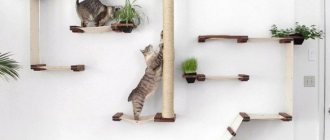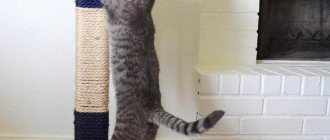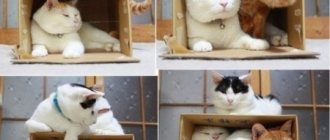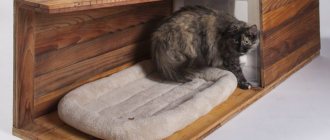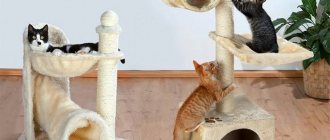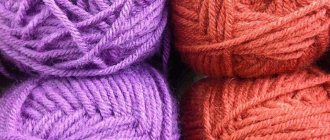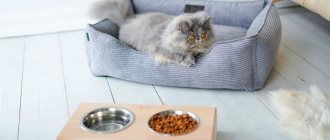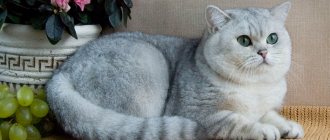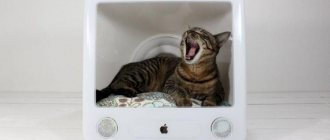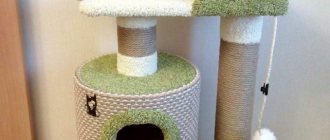In a house where there is an animal, especially a cat, furniture is often damaged by the sharp claws of pets. Torn sofas and armchairs are a common occurrence. But it is not possible to wean an animal from the habit and need to sharpen its claws, because this is its natural instinct.
The predator thus cleanses itself of the keratinized parts of its claws and marks its territory. Outdoor cats use trees in such cases, while indoor cats have a choice between furniture upholstery, carpets and wallpaper. And so that you don’t need to replace damaged furniture, you just need to get a scratching post.
It’s even better to make a scratching post for cats with your own hands - it’s much more economical. In this article we offer detailed instructions on how to make a scratching post for a cat with your own hands.
Advantages and disadvantages of homemade scratching posts
The only disadvantage of a homemade sharpener is the time spent on its manufacture. Purchasing consumables and tools does not count, because if you buy a finished product, you will probably pay more. Just by making the sharpener yourself, you will have at your disposal a completely safe, environmentally friendly product that is most suitable for your pet.
Store-bought scratching posts, even with the most primitive design, are usually not very cheap. Moreover, such an object may not be to the liking of a four-legged animal, and the animal will simply ignore it.
A store-bought accessory may not smell like that, especially if plastic and synthetics were used in its manufacture. As a result, you will waste money, and the problem of damaged furniture will remain unresolved. When you make a scratching post yourself, you will be able to take into account the preferences and tastes of your pet.
Is it worth purchasing used items?
Some owners make just such a decision in the hope of saving money. But this is a fundamentally wrong approach, because objects may smell like other people’s animals, which will most likely only scare away yours. And no one can guarantee the health and hygiene of the previous user of the accessory, thereby you risk infecting your cat with unpleasant diseases.
For creative people, creating a scratching post for your pet will only be a joy. You can completely rely on your imagination and come up with its design yourself. A creative approach to work will help you create an interesting and original household item that will adequately and harmoniously decorate the interior of the room.
Types of ropes
The question of what cat scratching posts are made of worries many owners who have decided to please their pet. There are several of the most common types of rope for a scratching post that can be used to wrap a post:
- Cotton rope. This material looks great and fits perfectly into any interior, but is much more expensive than other types.
- Sisal rope. Its cost is much lower, the structure is fleecy, the material is quite strong, durable with a grayish or pale yellow tint.
- Jute rope. This material is most often used in scratching posts that are sold in stores. Jute rope for scratching posts is the cheapest, but has less strength compared to previous materials.
All these materials differ radically from each other in a number of basic parameters, which primarily determine how long the scratching post will last. Therefore, next we will look at what ropes for scratching posts are called and compare their types to make it easier to systematize the information for the right choice.
Deciding on shapes and sizes
If your pet is large enough, then the sharpener should match its size. When creating a product, you first need to focus on the dimensions of the cat. Especially when you are making a wall model, otherwise the animal may scratch the wall.
The length of the scratching post should be 5-10 centimeters greater than the length of the animal itself (the tail does not need to be taken into account). The width of the product is oriented towards the width of the outstretched paws.
It’s not a bad idea to make a scratching post with a bed, if, of course, the dimensions of your home allow it.
Play complex for cats
A massive structure with houses, shelves, tunnels and scratching posts is difficult to make on your own. Craftsmen can be helped by step-by-step instructions with photos of a complex-level scratching post.
The product must be durable, stable and beautiful, as it will occupy a prominent place in the home.
Before starting work, you need to prepare materials:
- thick jute cord;
- metal corners of different sizes;
- 6 pieces of plywood 75x50 cm;
- stapler with staples;
- Whatman paper stencils;
- carpet
The complex will consist of 3 columns, 5 shelves and a rectangular house.
The most common models of claw sharpeners
There are two main types of scratchers: floor and wall. And each of them has its own varieties. Floor accessories can be flat (placed horizontally or at a certain angle), in the form of vertical columns, with additional elements: houses, ladders, etc.
According to most owners, vertical posts are the most convenient to use. They are often equipped with play accessories, this is especially true for kittens. The structure itself can be installed on any surface: floor, walls and even ceiling.
What tools will you need?
To make a comfortable cat house, you may need some tools:
- compass;
- markers or pencil for marking;
- fabric stapler;
- knife;
- ruler and tape measure;
- screwdrivers;
- screwdriver and drills;
- grinder (angle grinder with a disk for cutting wood) or jigsaw;
- hammer;
- pliers;
- drill;
- hatchet
- hot glue gun.
These tools are useful for scratching posts, depending on their design and complexity of design, technical features of the structure.
The most common mistakes when making scratching posts
To avoid having to redo the sharpener later, it is important to calculate its parameters in advance. It is necessary to pay attention to the following points:
- The height of the column is recommended to be at least one meter. And if you have a house or a bed, you can go higher.
- Width - no more than 10 centimeters.
- The location of the house is on top of the structure - cats love to relax at heights. And the bed placed underneath can be used by the animal as a toilet.
- If there is more than one animal in the house, then it is better to place the beds at the same height, otherwise the animals will compete with each other for the main roles.
- The accessory can be given gaming functions by hanging various toys from it.
DIY scratching post: step-by-step instructions, photos of various options
This type of sharpener is popular not only among lovers of homemade products, because making a scratching post for a cat is quite simple, but also among animals who happily use such products. To work, you will need to prepare a sheet of chipboard, which will be used as a stand. If this is not available, an old countertop or an unnecessary cabinet door will do. The main thing is that the base has sufficient width and is stable - then the animal will not overturn the structure on itself during play.
For the post you will need a base, timber and sisal rope
As for the shape, you can choose different options: rectangle, square, oval or any other fancy configuration. It is important that the shape gives stability to the sharpener and fits into the surrounding interior. It will be quite simple to make a perfectly round base using a compass, which is used to draw a line. It is best to cut with a jigsaw.
If desired, you can leave the base simply wooden, especially if beautiful natural wood was used for manufacturing, but you can also use some kind of upholstery, because there is a high probability that the animal will choose the product as a lounger. It is easy to cover the base with jute rope, which is secured to the side and placed in a spiral, moving towards the center.
The post is made from a metal or PVC pipe, or a strong tree branch with a diameter of at least 7-10 cm is suitable. Some experts suggest making a post from tin cans, inserted one into the other and connected with glue. To make the structure heavier and provide better stability, something heavy should be placed at the bottom of the first jar, for example, a piece of concrete or steel. You can wrap it around with the same carpet or rope. To connect the column and the base, furniture corners are suitable.
Helpful advice! If a wooden post is used, it can be either round or rectangular - in the form of a bar. The optimal height is considered to be 60-80 cm. More often the surface is left uncovered, but if the column is not very attractive, then it is additionally wrapped with cord.
The scratching post is the simplest and most popular option for making
If desired and if there is excess material, you can place an additional shelf at the top, which corresponds in shape and size to the base. It is not difficult to make a three-story structure in which the shelves are connected to each other by columns. In this way, a do-it-yourself climbing frame for cats is made, which is especially relevant for an active animal.
However, in this case, it must be taken into account that when the animal jumps on, the structure will be subject to significant load. To further attract attention, a rope with a toy attached to it is fixed on top.
Materials used
Making a scratching post with your own hands using step-by-step instructions is not that difficult. The main thing here is to use natural materials, because the sense of smell in four-legged animals is much more sensitive than in humans. Take materials that do not emit too pronounced and strong odor. For example, wood, jute or linen ropes, burlap, cardboard and the like. Natural fibers are very good at eliminating static electricity.
Artificially created materials can provoke an allergic reaction in a pet, which can have serious consequences. Forget about plastic - it is, in fact, an allergen, and even with an unpleasant odor.
The surface of the sharpener should be rough, but not very hard. It is important to pay attention to the strength and reliability of the product. And of course, safety, so that there are no broken claws or other injuries.
How to discourage a cat from sharpening its claws in a “forbidden” place
| First of all, a certain smell will help. Animals have a more highly developed sense of smell and some aromas are categorically unpleasant to them. The smell of alcohol, for example, or perfume.
Cats don't like the smell of all citrus fruits. You can purchase a special spray based on aromatic oils at the pet store. All rights reserved.
| Usually animals quickly abandon places where they are supposed to be in danger. A loud bang, a stern hail, and wrapping furniture in cellophane are also effective.
Many people recommend “water procedures” from a spray bottle, but this is possible if a cat is somewhere nearby trying to sharpen its claws, and the owner is sitting fully armed, waiting for her. Everyone can invent the ability to dare an animal themselves, knowing all its pros and cons.
.
Rug scratching post
This unique bed will become a comfortable place for your pet to rest. To create it you need to take a rug, any natural fiber rope, and a sisal fiber rope. We leave a place in the center of the rug for sharpening the claws, and cover the rest with sisal rope. The edges should also be glued so that the pet does not pull out the threads from there.
Such a structure can be left in a horizontal position, or attached to a wooden stand at an angle using a stapler.
Wall-mounted plywood option
The design is quite easy to manufacture; you just need to accurately calculate its parameters. It is better to make it 10 centimeters higher than the pet’s height, then he will not be able to leave scratches on the walls. The recommended width is at least 40 centimeters.
Prepare a couple of plywood sheets at least 25 cm wide (for a big cat, the parameters need to be larger). As a soft lining, you can use old carpet, which is attached to the plywood with the wrong side up. It is enough to fix the carpet with a stapler. Then the structure is attached to the wall, and the device is ready for use.
A wooden claw house is an excellent alternative to store-bought accessories. A log cut lengthwise is simply attached to the wall and wrapped in an old rug or bedding.
Constructions
Columns with platforms
Arrangement of a wooden scratching post with a bed
How a wooden scratching post with a bed is arranged can be seen in Fig. on right. The base is covered with fabric in advance; the bed - after installation in place. It is advisable to place batting or synthetic padding under the skin of the bed so that the cat does not feel the metal at all.
The first turn of the winding is glued with PVA, secured with tape and winding is carried out when the glue has dried. Another 2-3 turns are glued along the winding, as well as the last 2-3. They are also secured with tape before drying. There is no need to glue all the turns, so that it is easier to change the winding as it breaks, sorry, wears out.
Note: in a wooden climbing post with intermediate platforms, they are cut into the post already covered with fabric. Grooves are selected in the column with a margin for fabric; the platforms are attached with glue and self-tapping screws, wrapped through the post into the edges of the platforms. The fastener preparations will be hidden under the winding.
It would be easier to make a scratching post with a bed and a viewing platform using cardboard pipes. The diagram of its device is given in pos. I fig. below.
The assembly of the scratching post on cardboard poles is carried out in stages as follows:
- Holes in the base (1) for the posts are made with a feather drill or cut out with a jigsaw. No special precision is required, but an allowance of approx. 1 mm under the fabric.
- The base is covered with fabric in advance.
- After the glue dries, the fabric above the holes is cut with wedges, wrapped inside and on the underside with glue, as described above.
- Pipes (2) and (3) are also inserted with glue and immediately secured from the inside with small, 1.5-2.5 mm, self-tapping screws (4), 3-4 pieces each. onto the pipe evenly around the circumference. The installation holes for the screws are pricked with an awl.
- The bed (5) is first placed without covering, secured with self-tapping screws on a short pipe and set horizontally.
- On a long pipe, the bed is secured with a pin (pin) made of bamboo or hard wood (6) with glue. Pin diameter – approx. 3 mm; the hole for it, 0.5-0.7 mm narrower, will have to be drilled right through.
- The short pipe is plugged with a plug (7) made of dense foam plastic, soft wood, polyurethane foam, etc.
- Cover the bed with fabric (8). The hole in the pattern for the long post is cut out in advance.
- Into the joints (A) and (B) 3-4 drops of PVA diluted with 30-50% water are added evenly around the circumference.
- The observation platform (9) is installed in a similar way.
- Wrap the pillars with rope (10).
Note: on pos. II and III show how to form a kink in a cardboard pillar.
Corner
A corner scratching post is good, first of all, because it can cover a corner already favored by the animal: there is no need for repairs and making the cat new, which in this case is not always possible. Angles for cats, as mentioned above, are especially significant. It may be impossible to discourage, especially a cat, from a corner and off a pole or some type of plane (see below).
Corner scratching posts for cats
The main types of corner scratching posts are shown in the photo. The simplest one is a scratching post-book, 2 boards wrapped in rope, pos. 1, and connected by a hinge made of a strip of textile. The turns of the winding are most often all glued together; then, when the outer side is torn off, you can turn the scratching post with the “fresh” sides out. The ends of the boards before the wrapping are covered with fleecy or woolly, “catchy” fabric so that the cat can clean the claws on 3 paws while holding on to one.
The fact is that you can’t lower a simple corner scratching post to the floor: it interferes with cleaning and gets dirty. Cats, as you know, are clean. They will ignore the dirty cleaner and go scratch something else. Therefore, it is generally inconvenient for them to tear their claws on scratching posts, pos. 2, and not every cat accepts this product. You might even get nervous that your favorite corner is closed.
Corner attached scratching posts, pos. 3 and 4. The side ensures the cleanliness of the cleaner, and the owners can move it away during cleaning. However, to make an attached corner scratching post you will have to do a lot of work, see for example. video - master class below. However, the work can be simplified by building a corner attached scratching post from cardboard tubes and plywood, pos. 5.
Video: do-it-yourself corner scratching post for a cat
A special case is a corner wooden scratching post not in the corner, pos. 6. It will help to avoid many problems if several, up to 4, cats that do not form a pride live in a rather cramped room. Each has its own corner for pulling claws, and all together is a kind of border post.
Wall mounted
Sometimes cats, ignoring corners, tear at walls and it’s impossible to get them to use a normal scratching post. This is generally not typical for the cat breed, but it is not a pathology: in this case, it will be cheaper and easier to make a scratching post for a cat on the wall than to run to veterinarians and animal psychologists. But covering only the immediately scratched area with a small board with a cleaner, on the left in the figure, is wrong. Someday you will need to tear out your hind legs, and then there will be wallpaper, baseboards, and carpet. The cleaning surface of a wall-mounted scratching post should be no more than 12-17 cm from the floor so that the cat can reach it with its back paw, in the center. The ideal option, of course, is a wall-mounted scratching post with a bed on the right, but due to the presence of bent wooden parts, this is already a rather complex carpentry product.
Wall-mounted scratching posts for cats
Floor-standing
There are cats, and entire breeds of them, that don’t like not only to climb, but also to rear up. Persians, for example. Most likely, this is due to admixture in the gene pool from steppe cats; There are some among them who would rather drive a dog up a tree than climb it themselves. In this case, the cat needs a floor scratching post. This is basically the same board wrapped with rope, but with an emphasis on one edge, pos. 1 in Fig., so that you can practice claws while lying around for your own pleasure. Support/strut (position 2) – worse, with the hind legs it’s more difficult.
Floor scratching posts for cats
Some branded floor scratching posts for lazy cats are produced like the one in pos. 3. But this is pure marketing: on the rollers for the front paws, the claws often tear. Much more convenient and safer is the wave scratching post, pos. 4. It will suit both kittens and adults.
Cardboard
Container cardboard is a readily available material. Even a completely ignorant kitten can scratch its claws on it at random without the risk of damaging them. But adult cardboard scratching posts are only suitable for cats of small, weak breeds. A street scumbag who has been awarded a promotion for his good behavior will not clean his claws properly on cardboard, and will have to upset his owners by returning to street habits. By the way, not all small cats are weak. Try holding a Siamese or Abyssinian in your hands if she doesn’t want to.
Scratching posts for cats made of cardboard
The technology for making a cardboard scratching post is quite labor-intensive, but simple: strips or blanks are glued together in rows, pos. 1 in Fig., or spiral, pos. 2. In this way, sometimes very elegant products are obtained, pos. 3. It’s also easy to glue a wave scratching post from cardboard, pos. 5, or corner, attached or separate demarcation, pos. 6.
There are cardboard scratching posts on sale; most often - pillars of various configurations, pos. 4. Branded animal psychologists assure that there is some kind of cat sense in them, but the animals do not confirm this with their preferences, they would tear their claws, and that’s all.
House with a sharpener
A special kind of special type is the scratching post-house, see fig. You can accustom a cat to it only if it was adopted as a very young kitten. In this case, the conditioned reflexes acquired in safe human housing are able to prevail over the instinct for the safety of the lair, which has weakened there. Attempts by owners of this kind are justified if they take the cat to the dacha for a long time in the summer or, say, with them on vacation. The cat scratching post house is compact, lightweight, and does not cause any complaints from customs officers. And a cat in a familiar abode will not run wild and will not fall into hysterics in a strange environment.
Houses with scratching posts for cats
